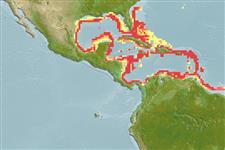Common names from other countries
Environment: milieu / climate zone / depth range / distribution range
Ecologia
marino batidemersale; distribuzione batimetrica 48 - 700 m (Ref. 13628), usually 250 - ? m (Ref. 13628). Deep-water; 32°N - 7°N
Western Atlantic: Canadian Scotian shelf to just north of the Amazon mouth.
Size / Peso / Age
Maturity: Lm ? range ? - ? cm
Max length : 24.3 cm TL maschio/sesso non determinato; (Ref. 13628)
Spine dorsali (totale) : 4; Raggi dorsali molli (totale) : 7 - 8; Spine anali: 0; Raggi anali molli: 6 - 7.
Found on muddy or sandy bottoms (Ref. 13628). Neither opercular spine gland nor anterolateral glandular groove with venom gland is present (Ref. 57406). Minimum depth from Ref. 58018.
Life cycle and mating behavior
Maturities | Riproduzione | Spawnings | Egg(s) | Fecundities | Larve
Davis, W.P and R. Fricke, 1990. Callionymidae. p. 921-924. In J.C. Quero, J.C. Hureau, C. Karrer, A. Post and L. Saldanha (eds.) Check-list of the fishes of the eastern tropical Atlantic (CLOFETA). JNICT, Lisbon, SEI, Paris; and UNESCO, Paris. Vol. 2. (Ref. 6941)
IUCN Red List Status (Ref. 130435)
CITES (Ref. 128078)
Not Evaluated
Threat to humans
Harmless
Human uses
Strumenti
Special reports
Download XML
Fonti Internet
Estimates based on models
Preferred temperature (Ref.
115969): 10.3 - 18.8, mean 14.4 (based on 41 cells).
Phylogenetic diversity index (Ref.
82804): PD
50 = 0.5020 [Uniqueness, from 0.5 = low to 2.0 = high].
Bayesian length-weight: a=0.00794 (0.00359 - 0.01758), b=2.80 (2.61 - 2.99), in cm Total Length, based on LWR estimates for this (Sub)family-body shape (Ref.
93245).
Trophic level (Ref.
69278): 3.4 ±0.4 se; based on size and trophs of closest relatives
Resilienza (Ref.
120179): Medio, tempo minimo di raddoppiamento della popolazione 1.4 - 4.4 anni (Preliminary K or Fecundity.).
Fishing Vulnerability (Ref.
59153): Low vulnerability (14 of 100).
